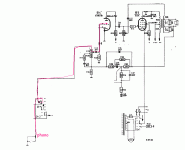Well, in those days turntables with crystal, not even ceramic, pickups were used as standard in connection with tube radios. Hence, it is no surprise that you didn't see a RIAA correction network in your unit.
Honestly, till today I didn't find any (European) tube radio with a RIAA preamplifier, not even a stereophonic one.
Best regards!
Honestly, till today I didn't find any (European) tube radio with a RIAA preamplifier, not even a stereophonic one.
Best regards!
Thank you Kay for confirming.
I have also looked at re-shelling the AG-3016 cartridge with the innards of a GP204 however talking to Martin from Mantra Audio the GP204 back shell seems to be fixed into the shell. The GP204 has a male rather than the AG3016 female connector. Most of the other donors are no longer available from my limited hunting across the internet.
I think the only way to make the phono operational is to to replace the deck, arm and cartridge and add a MM preamp given 100mV could easily be line level with the EABC80 running at 0.62mA and 75Va - the cathode is directly chassis connected according to the schematic, so the chassis would be floating giving the grid bias via the direct connection to the floating chassis. The chassis float must be literally <1V float - I'll check again with scope later this week when the parts arrive.
I have also looked at re-shelling the AG-3016 cartridge with the innards of a GP204 however talking to Martin from Mantra Audio the GP204 back shell seems to be fixed into the shell. The GP204 has a male rather than the AG3016 female connector. Most of the other donors are no longer available from my limited hunting across the internet.
I think the only way to make the phono operational is to to replace the deck, arm and cartridge and add a MM preamp given 100mV could easily be line level with the EABC80 running at 0.62mA and 75Va - the cathode is directly chassis connected according to the schematic, so the chassis would be floating giving the grid bias via the direct connection to the floating chassis. The chassis float must be literally <1V float - I'll check again with scope later this week when the parts arrive.
assumption that the design used a shared RF FM amp stage/phono stage
Agree this is mistaken.
"Phono" in those days was a high level cartridge with an output a lot like an AM detector. The overall slope of the "RIAA EQ" was part of the mechanism. The two bends near 500Hz and 2kHz might be approximated in mechanical resonances; or ignored. (This unit does have so much switching that maybe there is a bit of EQ fixing.)
That phono deck is part of the charm.only way to make the phono operational is to to replace the deck, arm and cartridge
I have simply replaced the ceramic needle with a $19 Grado or A-T MM needle. This does need a RIAA-style preamp, and the $10 Radio Shack box would work, but that's gone now. This depends on the changer working really well, low arm drag. Also of course whatever counterbalance floats the needle at a few grams.
Counterbalance? What counterbalance? Have a look at the pic in #1. In those days the sapphire styli at the end of those ultra high mass tonearms literally milled the music off the records 😉.
Best regards!
Best regards!
Lost the image."Phono" in those days was a high level cartridge with an output a lot like an AM detector.
Attachments
Looks much better with a lit bulb!
Recap complete. No hum or crackle.
Stations working, I need to check FM as I'm not picking anything without the aerial plugged in. The RF amp tube is hot. I'll get the scope out shortly.
Last edited:
Well, it is quite normal that your radio doesn't see anything without aerial 😉. Additionally, and as we say here: There ain't no better RF amplifier than a good antenna.
Best regards!
when assembled all good. The hammond transformer when screwed to the wook makes a audible mechanical hum.
So I replaced the temporary caps with the correct 2.2K and 4.7K caps and took a little video:
It surprises me just how clear the radio is and how little hiss or hum comes through. The main hum is simply the physical connection for the bucking transformer.
It surprises me just how clear the radio is and how little hiss or hum comes through. The main hum is simply the physical connection for the bucking transformer.
Well done! Btw, which caps did you mean? 2.2K and 4.7K might indicate resistors rather than caps (although per SI conventions kiloohms need to be abbreviated with k instead of K).
Best regards!
No the 2.2K & 4.7K were black pitch caps. I had subbed them for 22nF & 2pF initially that I had around - I figured if they block DC then that's good enough regardless of value given the location. Happier now the proper values are in place and it sounds better.
- Home
- Amplifiers
- Tubes / Valves
- Phillips H4X73A tube radio + record player
